Christopher Snowdon is plainly an anti-vaxxer, however well he tries to hide it. “Existing Covid vaccines are simply not good enough at preventing transmission and infection,” he writes. Hasn’t he read the trial results, showing 95% efficacy against infection for the Pfizer vaccine and 74% for the AstraZeneca vaccine? Or the large population study from Israel showing Pfizer’s 92% efficacy? Or the study from Public Health England showing 67% and 88% vaccine efficacy against the Delta variant for AstraZeneca and Pfizer vaccines respectively?
On what does he base his bald assertion that they are “not good enough at preventing transmission and infection”? Clearly not the science. He doesn’t appear to feel it necessary to give a single scientific reference for a claim that flies in the face of all these respectable studies, leaving the baffled reader assuming he must have picked it up in some article he read on an obscure website somewhere, presumably by a pseudo-scientific sceptic in denial.
This, of course, is not the way to go about intelligently criticising someone’s viewpoint. Which is precisely my point. As it happens, I agree with Christopher that the current vaccines are not very good at preventing infection or transmission, particularly now the Delta variant is in town. But I’m also aware that that is not the current mainstream scientific position (though it is based on recent official data and reports). Rather, it is currently a claim being circulated among the very networks that Christopher pillories in his recent piece in Quillette, naming and shaming the “coronavirus cranks”.
It seems, then, that Christopher is not averse to a spot of ‘crankery’ himself. But how helpful really is all this name-calling, mudslinging and smear by association? Science does not advance by consensus, by everyone agreeing, or by closing down dissenters. Christopher himself is evidently sceptical of one of the key mainstream vaccine claims – that they are highly effective against infection and transmission – so inadvertently places himself within the ambit of his own polemic. Indeed, at one point he fires a shot at the ‘smileys’, as he calls sceptics, for being sceptical of the vaccines, arguing the jabs “have been tested in clinical trials and have demonstrated their safety and effectiveness beyond reasonable doubt in recent months”. Yet he himself goes on to doubt their effectiveness!
The science of Covid is far from settled. Snowdon takes aim at some of the more colourful and dubious characters in the sceptic camp (criticising some claims I have no wish to defend, though he is hardly kind or charitable as he does so). But he notably leaves out of his cranky panorama some of the world’s most eminent scientists who take a sceptical line on a number of the issues he raises.
Sunetra Gupta, for instance, Professor of Theoretical Epidemiology at Oxford University; Martin Kulldorff, Professor of Medicine at Harvard University; Jay Bhattacharya, Professor of Medicine at Stanford University. These three authored the Great Barrington Declaration in October 2020 and have been active in calling attention to the massive collateral damage from lockdowns, especially among the disadvantaged and in the developing world, and proposing alternatives to such extreme and unprecedented disease control measures. Yet they do not receive even a passing mention in Christopher’s very partial rogues’ gallery of sceptics.
Or where is Professor Carl Heneghan, Director of the University of Oxford’s Centre for Evidence-Based Medicine; or Sucharit Bhakdi, former Chair of Medical Microbiology at the University of Mainz; or John Ioannidis, Professor of Medicine, Health Research and Policy at Stanford University? Or many of the other scientists and medics across the world who have publicly spoken out and published research questioning some of the claims being put out from official sources about the pandemic. These are not charlatans, they are not cranks, and they are not obscure individuals who speak with no understanding or authority. They may not always be right, but neither do they deserve to be attacked and smeared by journalists for setting out alternative scientific ways of looking at the data.
The heart of the sceptical position on lockdowns, shared by all these scientists, is that they are not worth it. This claim has a number of aspects, and not all sceptics sign up to all of them, though all the claims have some evidence to back them up. They are:
- The virus is not deadly enough to warrant the measures taken against it;
- The measures are not very effective at controlling the spread, or at least, not enough to justify the harms and costs;
- More focused measures would be sufficient, or at least, more justifiable in terms of harms and costs.
Other claims connected to these include questions about how well official definitions of cases, hospital admissions and deaths match up with actual clinical cases of the disease, the real extent of prior immunity, and the mode of transmission of the virus.
The vaccines are a largely separate matter, and not all lockdown sceptics are vaccine sceptics and vice-versa. The issues around the vaccines concern their novel genetic technology, the extreme speed at which they have been developed and approved under emergency authorisation, their questionable safety profile (with very high numbers of adverse events including fatalities being reported and serious side-effects being intermittently added to the warning label), and their real-world effectiveness.
It really shouldn’t need pointing out to liberal-minded people that all these questions are legitimate areas of scientific research and debate, and we should not assume that we already know the correct answer on each of them that would justify ‘fact-checking’, attacking and silencing all the rest. Indeed, Christopher himself questions the official narrative on vaccine efficacy, despite condemning sceptics for the same crime.
Christopher makes a number of specific claims in his piece that he seems to think are scientifically incontestable but in fact stand on very wobbly ground when given closer attention.
For instance, he asserts that the second wave in the U.K “lasted longer and killed more people”.
There were more Covid-related deaths between December 2020 and February 2021 than there had been in the first 11 months of the pandemic. At its peak, there were nearly twice as many people in hospital with the virus than there had been in March 2020. In Britain, as in most European countries, excess mortality went through the roof.
The data, however, tells a more complex story. Looking at the weekly total deaths, it’s clear that the second peak is much lower than the first (see below). The higher Covid mortality in winter compared to spring can be seen (blue bars) to be due to more of the non-excess deaths in winter being classed as Covid, whereas in spring there were many excess deaths beyond those defined as Covid (green bars). This discrepancy will likely have a number of factors behind it, but you have to think that how many people were being tested and treated as a Covid case has to play a large part, given that a Covid death is defined as a death from any cause within 28 days of a positive Covid test.
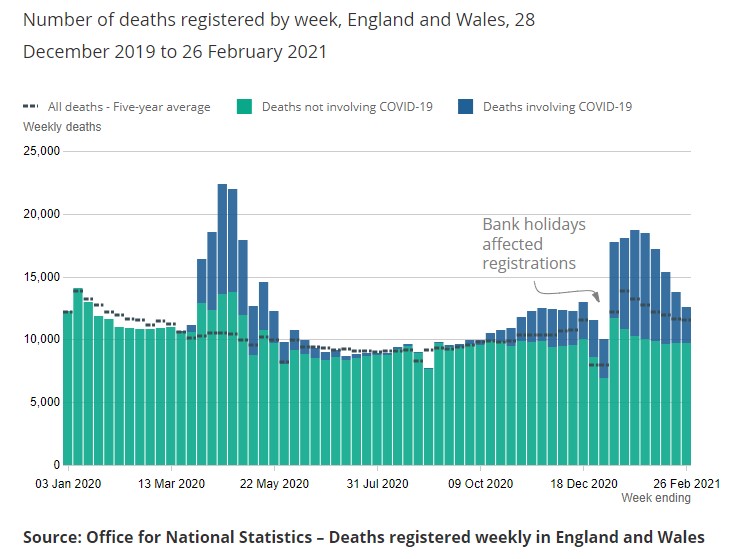
Note also that because it was winter the baseline was higher, meaning in percentage terms the excess peak was less than half the spring peak. This helps to put the winter epidemic into perspective.

The below average deaths since the end of winter have also meant that 2021 is now a below-average year for age-adjusted mortality (so far), the low mortality of the spring and summer having already cancelled out the high mortality of January and February.
Christopher is very critical of sceptics for questioning the reliability of the PCR test and the definitions of Covid case and death based on it. But this was a very live topic in autumn 2020, with a number of top scientists including Professor Carl Heneghan wading into the fray, as this correspondence in the BMJ records. The Lancet published a piece from NHS scientists in December stating that the operational false positive rate of PCR testing was estimated to be “somewhere between 0·8% and 4·0%”. Christopher argues: “The UK had a positivity rate of just 0.2% as recently as two months ago [May]. The false positive rate cannot possibly be higher than the positivity rate, but this simple logic continues to elude the Covid-sceptical community.” This simple logic is too simple, however, as it doesn’t grapple with the fact that the operational false positive rate can vary, including with the volume of tests.
Christopher claims U.K. infections fell in January because of the lockdown, but fails to engage with the fact that Sweden’s fell as well without a lockdown. In an attempt to write-off the significance of Sweden’s example of light restrictions, he argues that it became Europe’s Covid “hotspot” in the early spring. In fact, while Sweden’s positive cases went high, its deaths stayed low, while its excess deaths went through the floor.
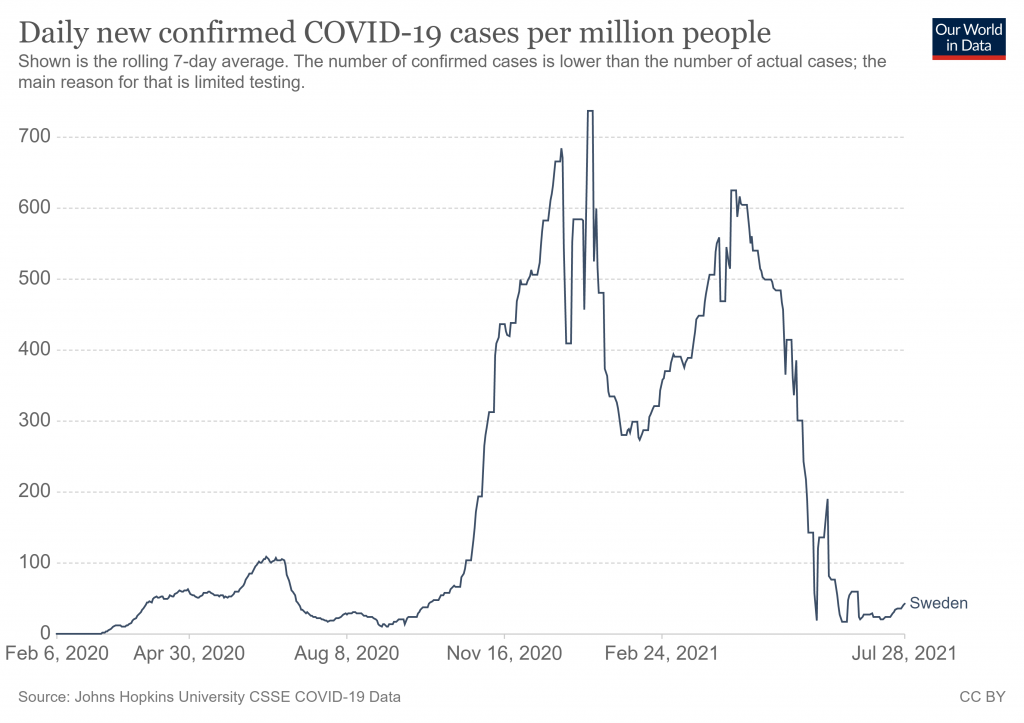

Apparently aware of this, Christopher argues that “in an encouraging sign of what was to come, vaccines began to have a clear impact on mortality in Sweden’s third wave”. Yet at the point that Sweden’s ‘third wave’ peaked in mid-April only 6.6% of the population was fully vaccinated, so it’s hard to credit that with having much impact on either infections or deaths. Infections in Sweden then entered sustained decline, again with no lockdown.
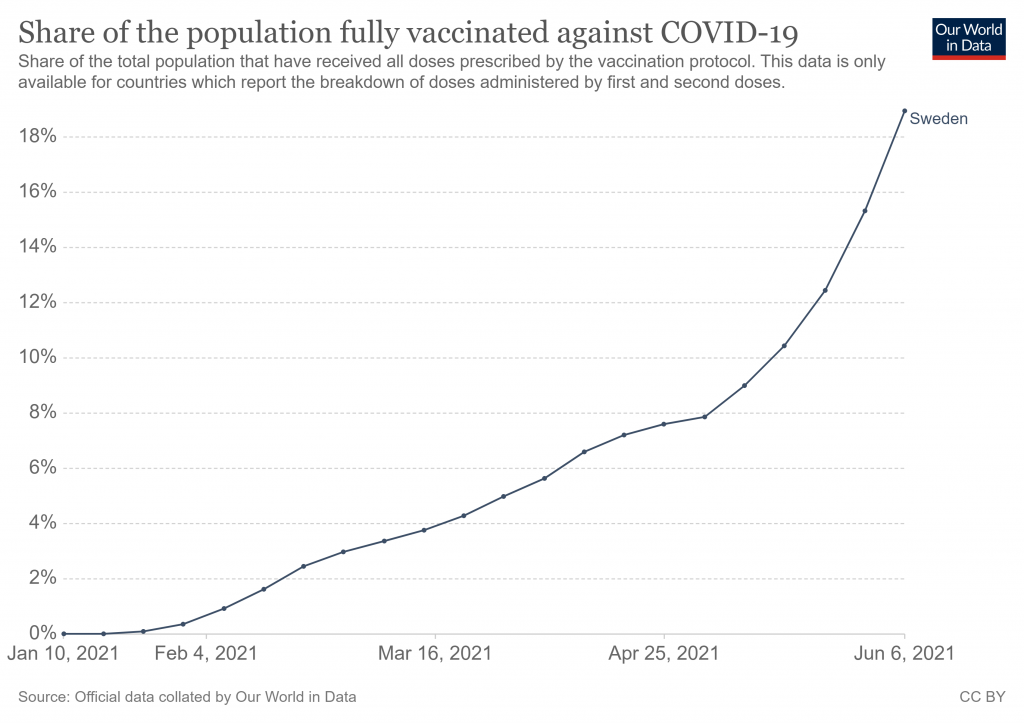
Florida is another place which defies the lockdown narrative, having lifted statewide restrictions in autumn 2020 and experienced a very similar winter to states which imposed harsh restrictions. Christopher, again, tries to dismiss its significance, saying it had a “large outbreak in the winter” and a “resurgence in early spring”. But the point is its winter outbreak was no worse than the outbreaks in lockdown states like California. And its spring ripple barely registered in additional recorded Covid deaths.
Christopher’s next iffy claim is that the U.K had an exit wave in spring: “As the U.K. relaxed restrictions and took a more Floridian approach, infections began doubling every two weeks.” This is not the case. The U.K., like a number of U.S. states, lifted many restrictions during the spring without seeing a new surge. In the U.K., as in the U.S., the surge only came along when the Delta variant arrived, not when restrictions were lifted – and in the U.K. it declined in July despite the lifting of restrictions.
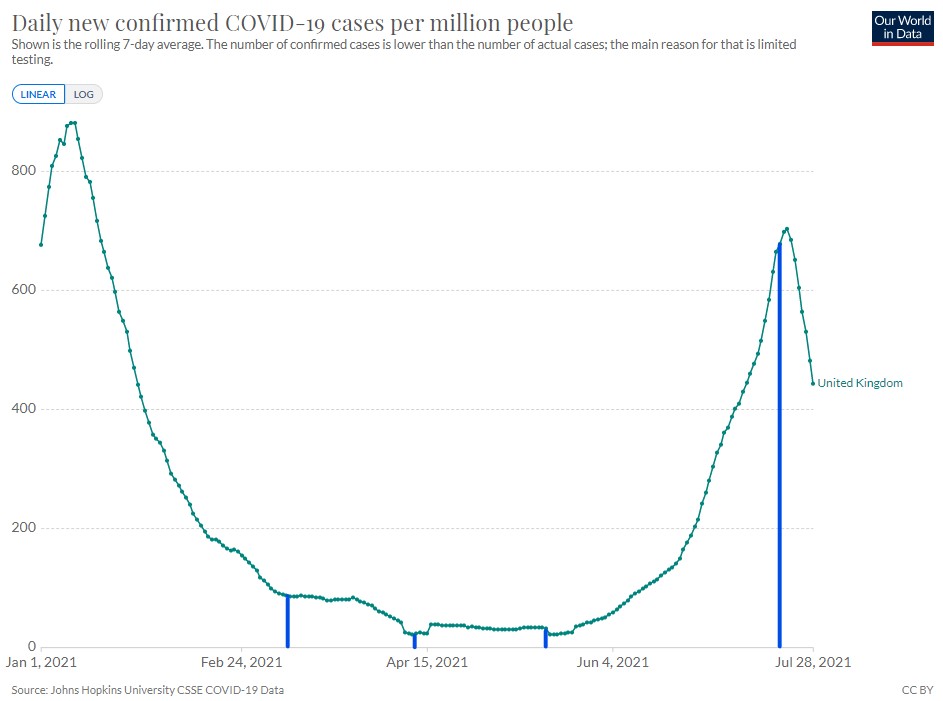
Christopher claims that it’s “the first time cases have dropped without heavy restrictions since the start of the pandemic”. If that was the case it is surely remarkable and demands explanation, particularly as Christopher believes that “herd immunity is unlikely to come from vaccination”, so he cannot join in the current trend of crediting the vaccines for the fall. But it’s also not true. Leaving aside that Sweden and numerous U.S. states saw infections drop without heavy restrictions, even in England infections have peaked and declined prior to lockdown on all three occasions – as Professor Simon Wood has shown in a peer-reviewed article, summarised in the Spectator.
We can also see the same thing on the below graph from Imperial’s REACT-2 study, which reconstructs the infection curve from the (self-reported) symptom-onset date of those who tested positive for antibodies in their survey.
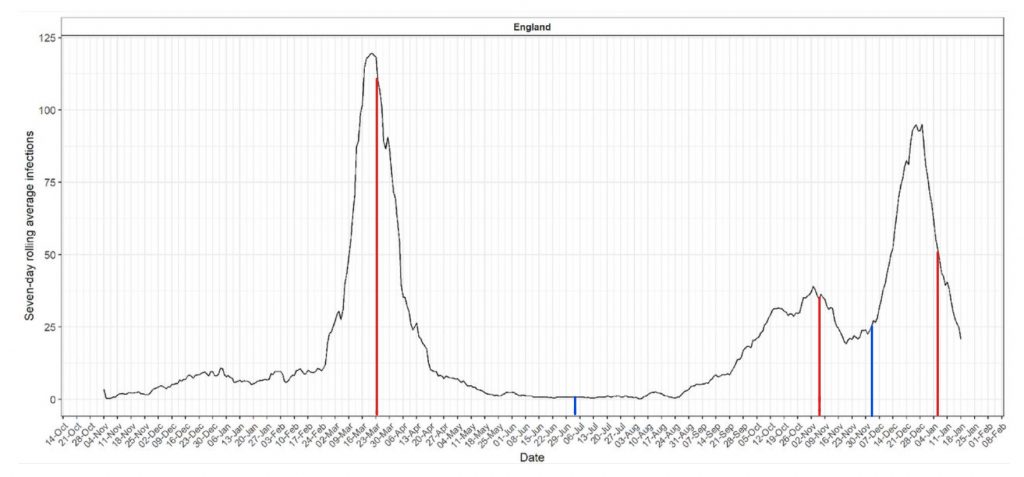
Christopher’s piece contains a number of other over-confident claims, delivered with uncharitable meanness and sneer, but it would become tedious to rebut every one. This will have to do for now. I’d like to think his next volley against sceptics (with whom I think he has more in common than he would like to admit) will acknowledge and engage with points like the ones set out here. But on past performance, somehow I doubt it.

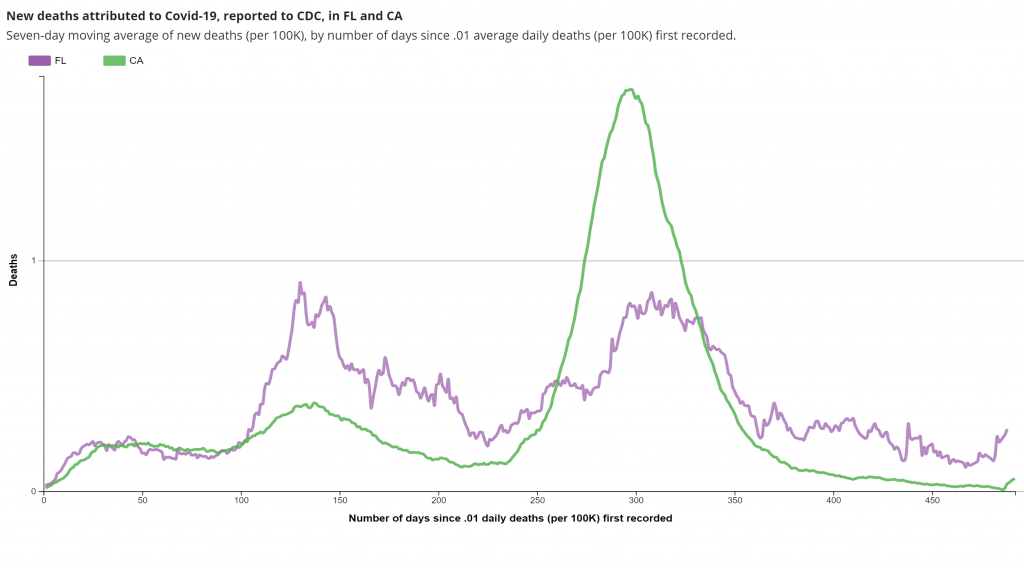











To join in with the discussion please make a donation to The Daily Sceptic.
Profanity and abuse will be removed and may lead to a permanent ban.
Well thats very telling isn’t it? Guilty as charged m’lord!
What a joke isn’t it?
A complete whitewash by the Convict party. Passing over the ‘end’ of the whitewash to the Labtards. The conclusion is known. Lock down harder, faster, go door to door with the poisons. Labour will rubber stamp this and the Convicts can then run against it as the party of ‘freedom’, blah blah. Arselings, criminals, corrupts.
According to Wikipedia, “The open sessions of the [Chilcot] inquiry commenced on 24 November 2009 and concluded on 2 February 2011. In 2012, the government vetoed the release to the inquiry of documents detailing minutes of Cabinet meetings in the days leading up to the invasion of Iraq in 2003.” I guess the Hallett inquiry will follow the same timescale or even lengthen it. Do you remember in 2020 when the weapons of mass infection were forty-five minutes away from a press conference every day?
Weapons of mass infection – good one. With the death tickers running every second on the BBC and WMI the only salvation. The lies around WMI are almost endless and ignored by Dame Overly-Plump’s inquiry.
Nice little 3min montage of experts from around the world saying the quiet parts out loud. Yes, it’s undoubtedly democide all the way down regarding all of this excess death. They can run but they can’t hide;
“The evidence is beyond a reasonable doubt that the vaccine is causing more deaths than the virus itself.”
Only after the Covid vaccines became compulsory we saw a spike in excess deaths “you have to be really stupid to not see the correlation!”
https://twitter.com/adhtvaus/status/1745312345306607814
“The truth is The truth is incontrovertible. Malice may attack it, ignorance may deride it, but in the end, there it is.” – W. Churchill
Heehee, you and your quotes. He wasn’t wrong there though was he? I would also add that you can’t run from it either. But what fresh madness do we have here? They’re going for maximum trolling now surely…Just when you think they are done insulting the general public’s intelligence…enter; a ”heart failure pandemic” FFS!! ( 4min clip );
He wasn’t wrong there though was he? I would also add that you can’t run from it either. But what fresh madness do we have here? They’re going for maximum trolling now surely…Just when you think they are done insulting the general public’s intelligence…enter; a ”heart failure pandemic” FFS!! ( 4min clip );
”Wow. Scientists are now warning that the latest COVID variant could trigger a “heart failure pandemic.”
And get this: Pfizer, the same company that sold you the so-called vaccines, is making a big bet on that “heart failure pandemic.”
The pharmaceutical giant recently acquired several companies. This includes a major $6.7 billion cash acquisition of Arena Pharmaceuticals, a firm specializing in developing treatments, particularly for heart inflammation conditions like myocarditis and pericarditis.”
https://twitter.com/VigilantFox/status/1745507029895061830
”Wow. Scientists are now warning that the latest COVID variant could trigger a “heart failure pandemic.”
Again? We really need a COVID variant triggering an idiot failure pandemic: Everytime some idiot wants to talk about another COVID variant now really doing all the gruesome stuff all its predecessors were supposed to do but never did, he just rolls over and self-ignites.
Well, I suppose in one way, they’re being truthful. What they’re not admitting is that the coming “new variant heart failure pandemic” has been caused by their jabs weakening the hearts of millions of jab recipients so that they have become far more vulnerable to any illness.
And the more jabs you had, the more susceptible you have become.
That’s just the old People dropping dead in the streets! story of February/ March 2020 recycled once again. And people are still always doing that because – OMFG! – all people eventually die. I’d certainly prefer to drop dead in the street because of a cardiac arrest to succumbing to an ear infection caused by people shouting nonsense scare stories into my ear all the time.
incumbents’ desire to keep their elected positions.
Not a chance in hell.
Who actually is responsible for this “postponement”.
And I don’t mean the cretin who announced it, I want to know who is ultimately responsible. ie the Real Puppet Masters.
Klaus and Billy.
The BBC this morning were explaining that ‘excess deaths’ this year were simply a consequence of an increasingly aged population (but, obviously, not those in 2020)……and that there weren’t that many really because January’s figures were really those who had died in December 2022. At this point, my driving became erratic and no hedge was safe……
Oh for heavens sake!
So according to bbc then, the 20 to 45 year old cohort is now elderly? because that cohort has seen the biggest increase in excess deaths!
The Establishment knows that of all the fronts they need to defend, the fall of the ‘vaccine’ narrative will destroy them.
If they were semi-honest and acknowledged the harm they might survive by blaming expediency – and bad scientists. However, to do so would risk Net-Zero (also harm and bad scientists).
Is it not the case that Emergency Use Authorization (EUA) was granted, in lieu of normal methods of testing? Perhaps they are worried that the way the product was promoted might end up in the same junk box as the Horizon cash handling product eventually.
I bet that will be rigorous and eclectic with a healthy dose of circumspection and admission of culpability. This is a big deal and they know it is a big deal and they are laughing in your faces faeces. They know the numbers. After all if you look at the doubling of claims for the disability benefit called PIP they can see the doubling that has occurred precisely in line with the introduction of the stabbination. They know the worldwide numbers, they know that the burden of the disabled will cripple society for decades to come. They know the impact on fertility and birth. They know it like the back of their hand and they monitor it because all of these indices point in the direction of their desired outcome.
There will be a general debate on trends in excess deaths in Westminster Hall on Tuesday 16 January 2024 at 9:30am, led by Andrew Bridgen, MP.
That will doubtlessly become another speech in front of an empty house …
I’m not sure it really matters when the inquiry into the vaccines happens as the conclusion of the inquiry is a foregone conclusion. Covid was such a serious threat that granting emergency use authorisation was fully justified and there may be a small number of deaths/serious injuries but the benefits far outweigh the harms, no doubt numerous dodgy computer models will be given precedence to show the vaccines saved 100,000’s of lives.
Ken Clarke in a bad wig.
Time off with full pay no doubt.
If you think the UK is corrupt. Look at the Democrats in the US. Unbelievable corruption going on there. The whole world needs to pray for Donald Trump. He’s the world’s only hope.
According to Briden, the Government wants it postponed for at least 20 years – so the guilty men and women are long-gone.
It’s pointless anyway – the Establishment will NEVER admit the level of harm caused by these dangerous jabs.
It will surely be just like the covid enquiry itself – ridiculously long, ruinously expensive, and above all hugely self-congratulatory to all who played a part. The only mistake that was made was to not go harder, faster and sooner with the vaccines, and mandates will definitely be imposed next time. If the evil Tories hadn’t been in power, we would have had even more vaccines even sooner!
5 years later…’Mistakes were made, lessons will be learnt, nobody knew, it was an emergency, noone was to blame, Boris Johnson’s to blame.’
Here’s an idea, Toby: The Sceptic should run a public enquiry on the vaccines with all sides given full opportunity to present their evidence. To complaints of lack of standing reply ‘Look at Hallett’.
Interesting idea, I would happily provide some evidence.
The Grenfell enquiry report has still not appeared. There was enormous guilt everywhere, but particularly in our rulers and their slaves. Hm….
“Will there ever be an honest official ‘Covid inquiry’?”
Um I wonder..not really there’s too much a stake for the truth ever to come out.